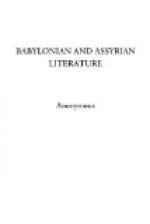the city of Tul-sa-Zabdani, Hirimu, Harute, the land
of Birate
131 and of Kardunias I annexed to the borders of my realm
and on the broad territory of Nairi I laid fresh tribute.
The city of Calach I took anew; the old mound
132 I threw down; to the top of the water I brought it; 120
hand-breadths in depth I made it good; a temple to Ninip
my Lord I therein founded; when
133 an image of Ninip himself which had not been made before,
in the reverence of my heart for his great mighty god-ship,
of mountain stone and brilliant gold I caused to make
in its completeness;
134 for my great divinity in the city of Calach I accounted
him: his festivals in the months of January and September[23]
I established: Bit-kursi which was unoccupied I
closed:
135 an altar to Ninip my Lord I therein consecrated: a temple
for Beltis, Sin, and Gulanu, Hea-Manna[24] and Yav
great ruler of heaven and earth I founded.
[Footnote 1: Probably the Lycus or upper Zab.]
[Footnote 2: The term “Hittites” is used in a large sense, as the equivalent of “Syrians,” including the northern parts of Palestine.]
[Footnote 3: About 881 B.C.]
[Footnote 4: A scriptural phrase of frequent occurrence.]
[Footnote 5: Corresponding to the Jewish month Tisri, and to part of our September, called in Accadian “the Holy Altar.”]
[Footnote 6: Cf. Gen. xi. 19, “Yet within three days shall Pharaoh lift up thy head from off thee.”]
[Footnote 7: About 880 B.C.]
[Footnote 8: The Hebrew Sivan.]
[Footnote 9: I.e., in comparison with.]
[Footnote 10: “Am” may be the name of some weight, or figure; v. Norr. Assyr. Dict., pp. 127 and 720.]
[Footnote 11: Menant renders, “j’ai fait etouffer dans le mur.”]
[Footnote 12: About 879 B.C.]
[Footnote 13: Goddesses.]
[Footnote 14: Urasi.]
[Footnote 15: Or, “Assur-sidi-huli” may be taken as the name of the town.]
[Footnote 16: “Urasi"(?).]
[Footnote 17: Compare a similar expression, Job xx. 23, “God shall rain (his fury) upon him while he is eating.”]
[Footnote 18: Cf. 2 Kings x. 8, “Lay ye them (the heads) in two heaps in the entering in of the gate.”]
[Footnote 19: Or, crosses.]
[Footnote 20: On the upper Tigris.]
[Footnote 21: I follow Dr. Oppert in the rendering of this obscure passage. Compare with Ammiba’al the name of the father of Bathsheba, which like many other proper names is indicative of the close relations between Assyria, Phoenicia, Syria, and Judea.]
[Footnote 22: This frequently recurring expression refers to the four races of Syria.]




